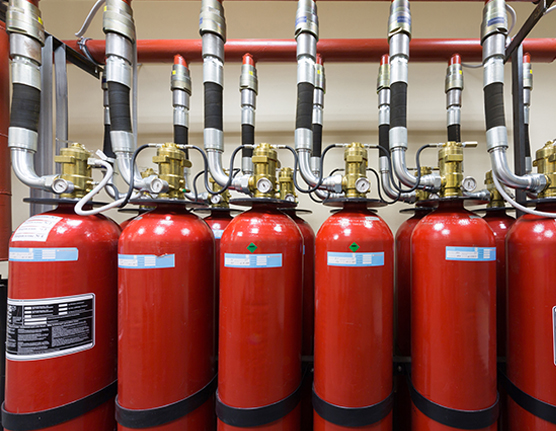DOT-Certified High-Pressure Compressed Gas Cylinder Testing in the Marietta, OH, Area
DOT-Certified High-Pressure Compressed Gas Cylinder Testing in the Marietta, OH, Area
Experienced Hydrostatic Testing for Compressed Gas Cylinders
High-pressure cylinders used to transport compressed gasses must be tested by a DOT-certified individual regularly to ensure safety and security. In addition to the hydrostatic testing we offer for fire extinguishers, Fire Extinguisher Specialists offers testing for high-pressure compressed gas cylinders up to 10,000 psi, as well. Hydrostatic testing (also known as a hydro test) checks the structural integrity of high-pressure cylinders by removing the valve and filling the container with water before pressurizing the container above its operating limit. A DOT-certified tester will measure the expansion of the cylinder and analyze it to ensure the cylinder does not expand beyond certain limits.
To learn more about the DOT-certified high-pressure compressed gas cylinder testing performed by Fire Extinguisher Specialists, contact us today! Give us a call at (740) 373-0515. Our experts can answer your questions and provide you with information about when you should test your high-pressure cylinders.
How Often Should You Test High-Pressure Cylinders?
How often you test your high-pressure compressed gas cylinder varies by the cylinder rating and when it was tested last. All cylinders are tested on a three, five, or ten year basis, and the duration between each test depends on the specifications of each individual cylinder. All high-pressure compressed gas cylinders have labels that include information for the specification and psi rating. For example, a DOT 3AA 1800 cylinder is a DOT-approved 3AA cylinder rated for 1,800 psi. Find information on how often your high-pressure compressed gas cylinder should be tested by a DOT-certified professional below.
Test Every Five Years
DOT 3A
ICC 3A
DOT 3AA
ICC 3AA
DOT 3AL
Test Every Three Years
DOT 3HT
Test Every 10 Years
DOT 3AA with a star after the last hydrostatic test date
Specialty cylinders like DOT E or DOT SP are manufactured and tested with special permits from the Department of Transportation.


What Happens if the High-Pressure Cylinder Fails the Hydrostatic Test?
If a high-pressure compressed gas cylinder fails a hydrostatic test, the DOT-certified tester will produce a test report for the customer and must destroy the high-pressure cylinder.
| Specification under which cylinder was made | Minimum test pressure (psig) 2 | Requalification period (years) |
|---|---|---|
| DOT 3 | 3000 psig | 5. |
| DOT 3A, 3AA | 5/3 times service pressure, except noncorrosive service (see § 180.209(g)) | 5, 10, or 12 (see § 180.209(b), (e), (f), (h), and (j)). |
| DOT 3AL | 5/3 times service pressure | 5, 10 or 12 (see § 180.209(e), (j) and § 180.209(m) 3). |
| DOT 3AX, 3AAX | 5/3 times service pressure | 5, 10 (see § 180.209(e)). |
| 3B, 3BN | 2 times service pressure (see § 180.209(g)) | 5 or 10 (see § 180.209(e), (f)). |
| 3E | Test not required. | |
| 3HT | 5/3 times service pressure | 3 (see §§ 180.209(k) and 180.213(c)). |
| 3T | 5/3 times service pressure | 5. |
| 4AA480 | 2 times service pressure (see § 180.209(g)) | 5 or 10 (see § 180.209(e) or (h)). |
| 4B, 4BA, 4BW, 4B-240ET | 2 times service pressure, except non-corrosive service (see § 180.209(g)) | 5, 10, or 12 (see § 180.209(e), (f), and (j)). |
| 4D, 4DA, 4DS | 2 times service | 5. |
| DOT 4E | 2 times service pressure, except non-corrosive (see § 180.209(g)) | 5 or 10 (see § 180.209(e)). |
| 4L | Test not required. | |
| 8, 8AL | 10 or 20 (see § 180.209(i)). | |
| Exemption or special permit cylinder | See current exemption or special permit | See current exemption or special permit. |
| Foreign cylinder (see § 173.301(j) of this subchapter for restrictions on use) | As marked on cylinder, but not less than 5/3 of any service or working pressure marking | 5 (see §§ 180.209(l) and 180.213(d)(2)). |
Retest and Inspection of Cylinders Table
Taken from Code of Federal Regulations Title 49 – Transportation § 180.209
1 Any cylinder not exceeding 2 inches outside diameter and less than 2 feet in length is excepted from volumetric expansion test.
2 For cylinders not marked with a service pressure, see § 173.301a(b) of this subchapter.
3 This provision does not apply to cylinders used for carbon dioxide, fire extinguisher, or other industrial gas service.
